There has been an increased prevalence in those suffering from functional gastrointestinal disorders (FGIDs) in recent years. Although pathophysiological mechanisms of the disorders have not been proven, it is hypothesised, among other causes, that intestinal inflammation and microflora shifts may have a significant effect. Therefore, there has been a substantial increase in research investigating the use of synbiotics for their treatment. Yet these are yet to be tailored to the specific branch of disorder patients are suffering from.
It is noted that the prevalence of FDr, a branch of FGIDs, is greater than the more widely researched disorder of irritable bowel syndrome (IBS). An indicator of FDr prevalence includes elevated levels of faecal calprotectin levels; a protein released from cells such as leukocytes indicating microinflammation, which results from alterations in gut microbiota.
Few studies have investigated the relationship between microinflammation and bacterial imbalance on those with FDr and high faecal calprotectin levels. This randomised, double-blind, placebo-controlled trial had the aim of observing the effectiveness of synbiotic administration on the symptoms of FDr in patients with elevated faecal calprotectin levels.
Study details:
The study utilised 40 participants randomly assigned to a placebo group or a synbiotic-treated group, over an eight-week period. The synbiotic treatment group was administered with the synbiotic LactominPlus (from NOVAREX Co) in a powder form at a dosage of 108 CFU per day (L. acidophilus ≥ 2.9 × 107, L. plantarum ≥ 4.7 × 107, and B. animalis subsp. lactis ≥ 2.4 × 107 CFU)
It was reported that FDr bowel symptoms, such as degree of formed stools and bowel movement satisfaction, all significantly increased in the synbiotic group at weeks four and eight.
Additionally, the analysed Lactobacillales populations were found to have increased by the end of the intervention period only in the synbiotic-treated group. This suggests that the strains present within the synbiotic were able to successfully survive and populate the gut microbiome.
Calprotectin levels had significantly decreased by the end of the intervention in this group, indicating reduced intestinal inflammation. However, the difference was not significant from the placebo group.
Beneficial bacteria
The findings suggest that over the eight-week period of administration, the multi-strain synbiotic resulted in significantly improved FDr symptoms and microinflammation of the gut following the successful increase in Lactobacillales population levels. It is hypothesised that these benefits may result, in part, from L. Plantarum regulating IL-6 levels when used in combination with additional strains.
Further mechanisms of action may result from the workings of the gut-brain axis, with researchers stating, “The ingestion of Lactobacillus can modulate central GABA receptor expression via the vagus nerve”.
“GABA production or the activation of GABA receptors is known to be involved in physiological intestinal motility and secretion, intestinal inflammation, and immune regulation through crosstalk with the gut–brain axis.”
Study significance:
There is a general lack of studies investigating whether multi-strain or single-strain treatments are most beneficial for patients with bowel disorders. Due to the complexities of the gut microbiome, studies have provided varying results mirroring the vast variation of disease and bacterial strains utilised.
However, researchers highlight a recent meta-analysis which concluded that a combination of probiotics may be more effective in treating IBS. It was found that symptoms were alleviated when probiotics consisting of Lactobacillus and Bifidobacterium strains were administered, giving further validity to the findings observed in the present study.
Although the study suggests that the multi-strain treatment was effective in improving disease symptoms in patients with high faecal calprotectin levels, further long-term studies are required to understand if these observations are sustained. This requirement is further highlighted in the finding that the FDr patients did not show a significant reduction in microinflammation when compared to the control.
Source: Nutrients
https://doi.org/10.3390/nu14235017
“A Randomized, Double-Blind, Placebo-Controlled Trial to Evaluate the Effects of Multi-Strain Synbiotic in Patients with Functional Diarrhea and High Fecal Calprotectin Levels: A Pilot Study”
Susie Jung, Kwang-Min Kim, Sung-Min Youn and Kyu-Nam Kim.

